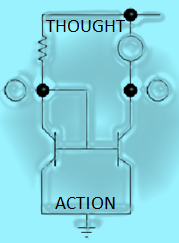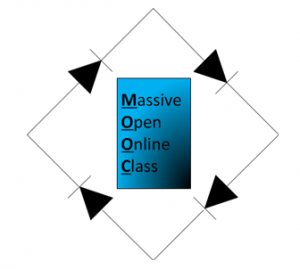Move a Cursor with Your Mind
Sunday, February 23rd, 2014 In one of my cognitive design workshops I have participants work with commercially available brain-computer interfaces and try to move an object on the computer screen with their mind. This frustrates most participants but for the 25% that can do it well it is a transformational experience. By relaxing or giving a thought command (e.g. “go up”), a mental state is translated into an action of the computer screen. Through trial and error they learn to adjust their mental states to get the desired outcome on the computer screen. For the first time a multi-media representation of an internal thought or feeling is used as a feedback signal to drive learning.
In one of my cognitive design workshops I have participants work with commercially available brain-computer interfaces and try to move an object on the computer screen with their mind. This frustrates most participants but for the 25% that can do it well it is a transformational experience. By relaxing or giving a thought command (e.g. “go up”), a mental state is translated into an action of the computer screen. Through trial and error they learn to adjust their mental states to get the desired outcome on the computer screen. For the first time a multi-media representation of an internal thought or feeling is used as a feedback signal to drive learning.
This simple exercise (when it works) demonstrates how the latest brain science can revolutionize our approach to learning, decision-making, creativity and other cognitive and mental performances.
This is basic neurofeedback but until you do it you lack the direct experience that is so valuable for excellence in design and innovation work.
Neurofeeback is not the only experience a cognitive designer needs. Others include plasticity, mirror neurons, cognitive illusions, magnetic stimulation, electrical stimulation (e.g. transcranial electric stimulation) and other forms of neuromodulation that are informed by the latest brain science. For readable review of some of the recent research check out Education and Neuroscience: An Expert Review on the ThInk blog.
While the promise that neuroscience holds for improving education and all brain-intense human activities is tremendous, progress has been slow and is likely to remain so. As one of the researchers points out:
“Realistically, on current trends, future development is likely to be slow, especially given the ethical and safety concerns”
One way to speed things up is to make creative use of approaches that have already proven to be safe and effective. That is why I spend my time creating experiences for designers and innovators. With simple brain computer interfaces, neuromodulators and magic kits we can already disclose new worlds.
Once seen there is no going back. Learning to move a cursor (or any object) with your mind is a gateway experience for would-be cognitive designers. How many design and innovation courses or programs offer that?

